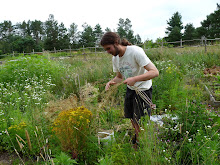#1 - After harvesting the dry pods (Mizuna in this case) I'll let them dry further for another couple days in the greenhouse or in the barn. Once the pods are super-crispy and brown and
break apart with a slight touch you know they're ready to thresh!

#2 - My strategy for brassica seeds is to put the dry pods in a pillow case (which you should be sure doesn't have any holes!) and then to smash them any which way we can. You can hit it against a wall, stomp on it, knead it in your hands, flail it, run it over in the car... those little seeds are pretty indestructible. After a minute or two of work the pods are usually all broken open (it doesn't take much if they're dry enough) and have released they're seeds inside the bag. Now you just need to separate the seeds and the chaff...

#3 - I usually just grab the large top pieces of stem and shells and remove them by hand (that's what's in the wheelbarrow here) , the seeds are heavy and almost always settle in the bottom of the bag. To separate the seeds from the smaller chaff we use both screens and winnowing.

#4 - Screens sure are handy! The seeds drop right into the bucket and the pods stay on top. We were lucky to be gifted this awesome brassica seed screen, but any old homemade screen will do. It's handy having different sizes of mesh for different sized seeds.

#5 - The final step is winnowing. The screen gets most of the chaff out but if you want them really clean winnowing is often the way to go. It's just pouring the seeds back and forth between two containers in the wind, the heavy seeds fall and get caught while the lighter chaff gets blown away. A fan works wonders on those non-windy days.

#6 - Voila! The finished seeds! These two buckets are before and after winnowing, you can see how much cleaner they are afterwards.







